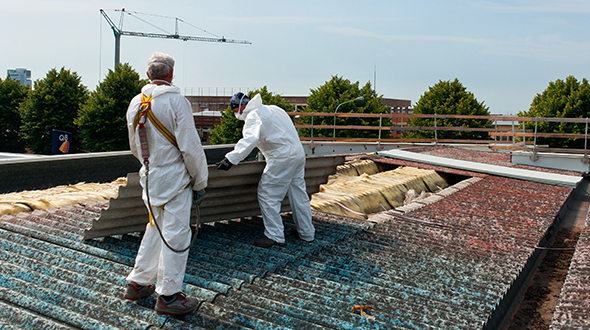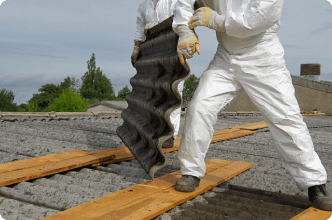Best Practices For Asbestos Roof Removal In Sydney Risks Associated With Asbestos Roofs
The asbestos removal process is a meticulous and critical method to ensuring safety in buildings contaminated with this hazardous material. Asbestos, once widely used for insulation and fireproofing, is now identified for its critical health risks, including lung most cancers and mesothelioma. Addressing the difficulty effectively calls for a complete understanding of each the health implications and the technical steps concerned in safe removal.
Before commencing the asbestos removal process, a thorough inspection of the property is performed. Trained professionals usually perform surveys to identify the presence, location, and condition of asbestos-containing materials (ACMs). This assessment is essential in determining the extent of contamination and the most effective strategies for removal or encapsulation.
Once the preliminary inspection is completed, the following step entails formulating an in depth asbestos removal plan. This document outlines the mandatory precautions, methodologies, and regulatory requirements that must be adhered to through the process. It is crucial for guaranteeing that all parties concerned are aware of the risks and the procedures designed to mitigate these risks.
A important part of the asbestos removal process is securing the work space. Effective containment is essential in preventing the fiber from escaping into the encompassing environment. This typically consists of sealing off the realm utilizing plastic sheeting, adverse air stress systems, and warning signs to limit entry and protect people from exposure.
Resources For Asbestos Roof Liability Coverage Cost To Remove Asbestos Garage
Personal protective equipment (PPE) plays a big function in maintaining safety through the removal process. Workers involved within the operation are required to wear specialized clothes, respirators, and eye safety to attenuate their risk of inhaling asbestos fibers - Asbestos Roof Removal Permits In Sydney. Ensuring that correct PPE is used persistently is significant to the health and safety of all personnel on-site
Once the realm is secured, professionals can begin the precise asbestos removal. Using specialised instruments and techniques, they carefully dismantle and remove the asbestos materials. This stage calls for a high degree of experience and attention to detail to ensure that no fibers are launched into the air. The materials are usually placed in sealed containers designed to forestall any potential leakage.

After the asbestos has been successfully removed, thorough decontamination of the world is critical. This includes cleansing surfaces, tools, and equipment used during the process to get rid of any remaining traces of asbestos. The decontamination method usually includes damp wiping and vacuuming utilizing high-efficiency particulate air (HEPA) filters, which seize even the smallest fibers.
Asbestos Removal Project Completion Protocols Video Guides For Safe Removal
Following decontamination, the following phase includes the disposal of the asbestos materials. Proper disposal is critical, as improper handling can pose significant health risks. In most circumstances, asbestos waste must be taken to licensed disposal websites that are geared up to deal with hazardous materials. Transporting asbestos requires additional precautions to ensure that no fibers are released throughout transit.
In many regions, the asbestos removal professionals must provide documentation to confirm the safe completion of the removal process. This documentation is commonly required for regulatory compliance and serves as proof that the services had been rendered in accordance with safety requirements. Documentation sometimes includes particulars of the inspection, removal, disposal, and any air high quality testing carried out after the job has been finished.
Air quality testing is often performed following asbestos removal to substantiate that no residual fibers stay in the environment. This is an important step for assuring the protection of the property and the well-being of its occupants. Samples taken from the air are analyzed to determine whether the realm is safe for occupancy before any renovation or re-use takes place.
Asbestos Roof Removal Services In Sydney Costs Associated With Removal And Replacement
The whole asbestos removal process not only requires technical proficiency however should additionally comply with local regulations and guidelines. Adhering to those standards is essential for both legal compliance and for shielding the health of employees and most of the people. Regulatory bodies usually set strict requirements concerning every step, from initial inspection to last air clearance testing.
Asbestos removal is not just about eradicating the fabric; it often entails intensive planning, execution, and follow-up. Each project is unique, influenced by factors such as the sort of building, the situation of the asbestos, and the situation of the materials. Effective communication between all stakeholders is essential for the graceful execution of the process.
Asbestos Roof Removal Best Contractors In Sydney Asbestos Storm Damage Services
Despite the health risks related to asbestos, the materials still exist in many older buildings. Consequently, the demand for skilled professionals skilled within the asbestos removal process is on the rise. Training and certification packages ensure that staff are well-versed in safety protocols and expert removal techniques.
Understanding the complexities of the asbestos removal process highlights the importance of hiring certified professionals. Attempting to deal with asbestos issues with out proper training and resources can lead to extreme health risks and legal ramifications. Awareness and education in regards to the dangers of asbestos play a crucial role in preventive measures and community health.
As the awareness of asbestos-related hazards continues to develop, effective remediation efforts are very important. The asbestos removal process can safeguard the health of individuals and communities. By addressing present contamination correctly, it is possible to create safer residing and working environments for future generations.
Cost Of Asbestos Roof Removal In Sydney Asbestos Storm Damage Services

Given the significant health risks related to asbestos exposure, it's important to take all essential precautions during the removal process. This ensures that asbestos fibers do not linger within the environment, thus defending people's health and well-being. The ongoing battle towards the hazards of asbestos continues, but with adherence to safe practices, the removal process may be conducted effectively and responsibly.
Importance additionally lies in steady schooling relating to the asbestos removal process. Homeowners, building managers, and contractors must stay informed about the latest regulations, techniques, and safety measures. Asbestos Roof Encapsulation Alternatives. By staying up to date, they can help to attenuate risks and ensure that any needed work is accomplished safely
Ultimately, the asbestos removal process requires a mix of technical experience, strategic planning, and unwavering commitment to safety. The health risks related to asbestos are well-documented, making effective removal critical in preserving public health. Through diligent efforts, it is potential to mitigate these risks and contribute to safer environments for all.
- The asbestos removal process begins with an intensive inspection of the property to identify the areas and types of asbestos-containing materials (ACMs).
- A detailed risk assessment is conducted to judge the potential hazards associated with the identified ACMs, contemplating factors like their condition and accessibility.
- Before removal starts, the area is sealed off with plastic sheeting to prevent the unfold of asbestos fibers into other areas of the building.
- Workers are required to put on private protective equipment (PPE), together with respirators, to attenuate exposure to airborne asbestos particles in the course of the removal process.
- Specialized instruments and techniques, corresponding to moist removal methods, are sometimes employed to maintain asbestos fibers damp and scale back the chance of airborne contamination.
- All asbestos waste is rigorously packaged in labeled, leak-tight containers to make sure safe transportation and disposal in designated amenities.
- Post-removal inspections and air quality checks are critical steps to confirm that the environment is freed from asbestos fibers and safe for reoccupation.
- Professional abatement contractors typically present documentation verifying compliance with local regulations and the correct handling of asbestos materials.
- As part of the method, it's important to inform and educate building occupants in regards to the planned removal to make sure safety and minimal disruption.
- Continuous monitoring of the worksite in the course of the removal is implemented to maintain safety standards and rapidly address any incidents which will happen.undefinedWhat are the signs that I want asbestos removal in my home?undefinedCommon signs include seen asbestos materials, such as textured ceilings or insulation, in addition to deteriorating materials that will release fibers. If your house was built before 1980, it's advisable to have an expert inspection.
Community Support For Asbestos Affected Areas Cost To Remove Asbestos Garage
How does the asbestos removal process begin?undefinedThe process typically starts with an intensive inspection by certified professionals who assess the extent of asbestos presence. They might take samples for laboratory evaluation to determine the sort and hazard stage.
Is asbestos removal safe?undefinedYes, when carried out by educated professionals, the asbestos removal process is safe. Proper safety protocols, equipment, and containment measures minimize the risk of fiber launch during removal.
Monitoring And Maintaining Safety Standards Removal And Disposal Of Asbestos
What steps are concerned in asbestos removal?undefinedThe process often involves inspection, containment of the work space, removal of asbestos-containing materials, and thorough cleaning of the location. Asbestos Roof Removal Timeline In Sydney. Final air high quality checks are sometimes conducted to make sure safety
How long does the asbestos removal process take?undefinedThe period varies based mostly on the quantity and sort of asbestos. Smaller jobs could take a few hours, while intensive removal could take a quantity of days or even weeks. Consultation with professionals can provide a extra precise estimate.
Will I have to vacate my home throughout removal?undefinedYes, it is typically recommended to vacate the premises through the removal process to ensure safety. Professionals will advise on the period of your absence primarily based on the scope of work.
Importance Of Documentation In Asbestos Projects Diy Awareness For Asbestos Removal

What are the prices associated with asbestos removal?undefinedCosts can range widely relying on factors like the type and quantity of asbestos, location, and required air quality testing. It's best to get multiple quotes from certified contractors to match.
How can I find a qualified asbestos removal contractor?undefinedLook for licensed and licensed professionals with experience in asbestos remediation. Verify their credentials, learn reviews, and ask for references to make sure they adhere to safety and regulatory requirements.
Asbestos Removal Emergency Response Plans Cost To Remove Asbestos Garage
Are there any health risks if asbestos is not removed promptly?undefinedYes, extended exposure to asbestos can lead to serious health conditions, together with asbestosis and lung cancer. It's important to address asbestos considerations rapidly to minimize health risks.
What occurs to the asbestos after removal?undefinedThe eliminated asbestos material must be disposed of in accordance with native regulations. Licensed disposal amenities be sure that asbestos waste is dealt with safely and appropriately to prevent environmental contamination.
monitoring and maintaining safety standards useful source